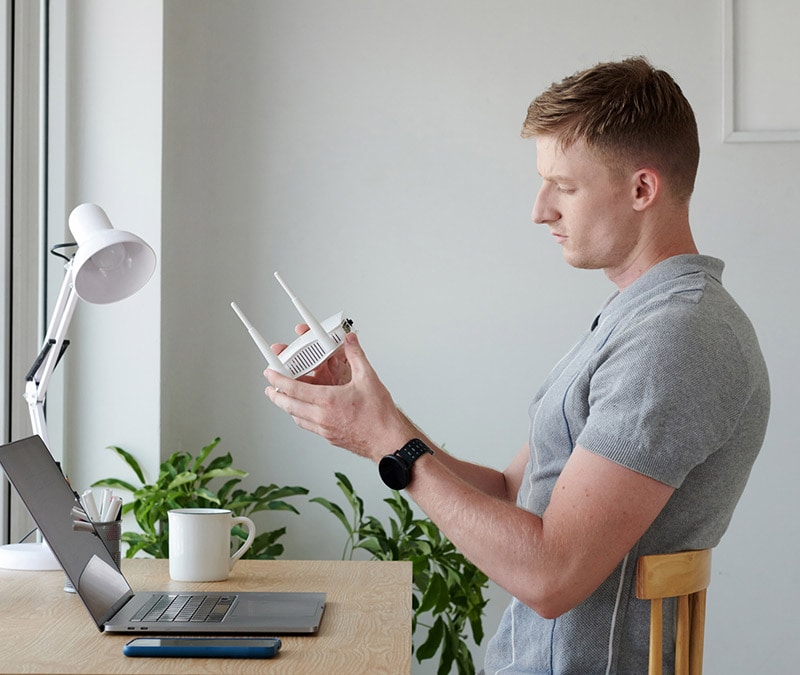Is your computer haunted? No, it’s probably malware
Unexplained pop-ups? Messages from beyond? Disabled security systems? It almost sounds like something out of a horror movie. But chances are, your computer isn’t haunted—it’s probably malware. Check out the signs of infection, and how to protect yourself from these digital ghosts … if you dare.

Have you ever felt like there's a ghost lurking inside your computer? Unwanted pop-ups, inexplicable slowdowns, and other strange behavior from your device may feel like an otherworldly occurrence. But before you call an exorcist, you might want to consider a more tangible culprit: malware.
What is malware?
Malware—short for malicious software—is specifically designed to harm, exploit, or perform other nefarious activities on a device, network, or software. Cybercriminals deploy malware in different ways, often with the end goal of either stealing information or damaging a computer system for monetary gain.
Let’s look at some types of malware you need to watch out for:
Viruses
A virus is malicious code that attaches itself to programs or files. Once inside your system, they can steal data, launch attacks, or send copies of themselves to your contacts to infect their devices.
Worms
Worms act like viruses but don’t need to be attached to software. They can spread through email attachments, DMs, or compromised websites.
Trojans
This type of malware disguises itself as legitimate files. Like viruses and worms, Trojans can steal data, wreak havoc on your system, or give criminals control over your device.
Ransomware
Ransomware can take over or lock you out of your device, holding your data hostage until you pay a ransom. It often involves double extortion tactics, where criminals threaten to release sensitive data if demands aren’t met.
Spyware
Spyware secretly monitors your activities. It can record keystrokes, steal passwords, and pass sensitive data, like your bank information, to cybercriminals.
Bots
Bots infect your system and allow attackers to take control of your device remotely. Often, bots work together in networks (botnets) to carry out large-scale attacks on websites or other systems.
6 Signs your computer may be haunted by malware
- Unexpected pop-ups: Ads that appear out of nowhere and might even “talk” to you. It’s creepy, but it’s likely adware, not entities from the beyond.
- Slow performance: Sudden and unexplained slowdowns, even if you aren’t running heavy programs, may fill you with dread.
- Suspicious hard drive activity: An overactive hard drive, even when the computer is idle, can be a sign that something nefarious is lurking in your system.
- Unauthorized emails or messages: Friends or colleagues telling you they received strange and unusual messages from you? That’s a red flag that your system might be compromised.
- Disabled security solutions: If your antivirus or firewall is mysteriously turned off, it could feel like the work of a digital poltergeist—but it’s more likely malware trying to sneak past your defenses.
- Modified files or programs: Unexplained changes in files or program behavior can leave you wondering what kind of malevolent entity is lurking in your system.
How malware finds its way to your device
Malware can get onto your device in various ways. Watch out for these common methods cybercriminals use to infect your devices with this spooky software designed to access, disrupt or damage your system.
- Phishing emails or texts: With the advent of AI, phishing scams have become more convincing. Deceptive emails or texts are sent to lure you into clicking on malicious links that can infect your device with malware.
- Drive-by downloads: For drive-by download to work, you don’t always need to click “download” to get infected. Visiting a compromised website can cause your device to pick up malware in the background.
- Infected USB drives: Like the original monster movies, sharing data through USBs might seem old-school. Yet, it’s still a common way malware can jump from one device to another.
- Software downloads: Cybercriminals can hide malware within seemingly legitimate software installations, at times even in app stores or browser extensions.
- Fake antivirus pop-ups: You might see a scary warning that your device is infected and needs immediate attention. Don’t fall for it for this trick. These pop-ups are often malware disguised as helpful software.
How to help protect yourself against the digital ghosts
Cybercriminals are getting smarter, but so are cybersecurity tools. Here are five ways to protect yourself from these digital ghosts that aim to haunt your devices:
- Keep everything up to date. Make sure to update your operating system, apps, and software regularly. Updates often include security patches that close vulnerabilities cybercriminals can exploit.
- Install a trusted cybersecurity software. Choose a well-reviewed and regularly updated antivirus suite like Norton 360. Advanced features like AI-powered threat detection and VPNs are essential to stay ahead of new forms of malware.
- Use a firewall. Whether it’s hardware or software-based, a firewall helps block unwanted traffic and keeps your network secure.
- Be cautious of links and downloads. Never click on suspicious links or download attachments from unknown sources. Tools like Norton Genie can help identify scams before you fall victim.
- Back up your data regularly. Regular backups protect you from ransomware and other attacks. If malware does strike, you’ll have safe copies of your important files.
Keep the spookies at bay
While haunted computers make for an entertaining tale, the real threats are way more sinister. Malware has grown smarter and sneakier. But with the right tools and habits, you can keep your devices safe. Stay informed, stay vigilant, and make sure your digital ghosts are nothing more than scary stories.
Editorial note: Our articles provide educational information for you. Our offerings may not cover or protect against every type of crime, fraud, or threat we write about. Our goal is to increase awareness about Cyber Safety. Please review complete Terms during enrollment or setup. Remember that no one can prevent all identity theft or cybercrime, and that LifeLock does not monitor all transactions at all businesses. The Norton and LifeLock brands are part of Gen Digital Inc.





Want more?
Follow us for all the latest news, tips, and updates.